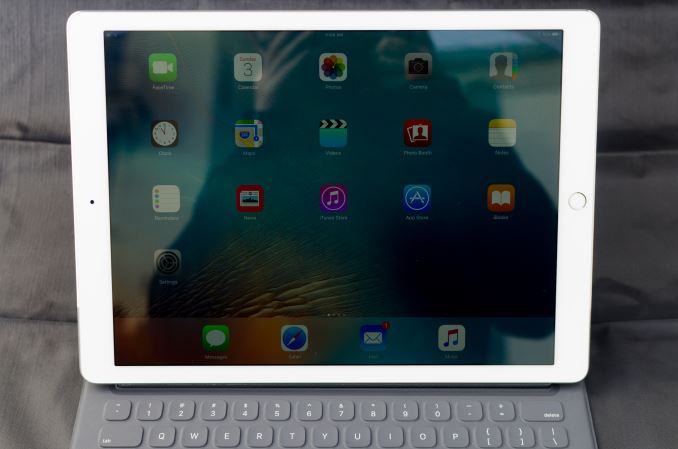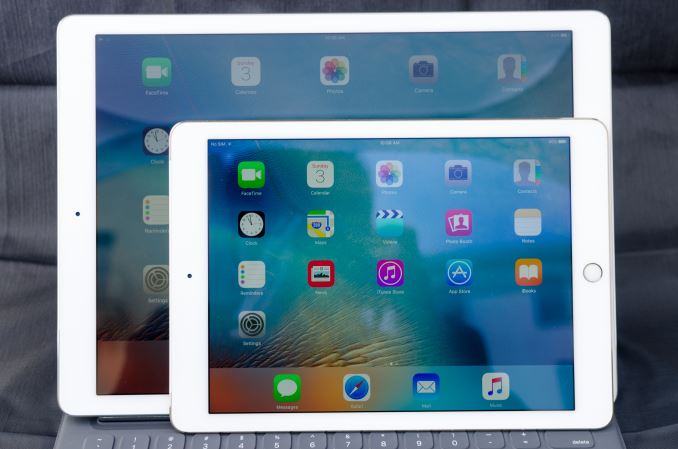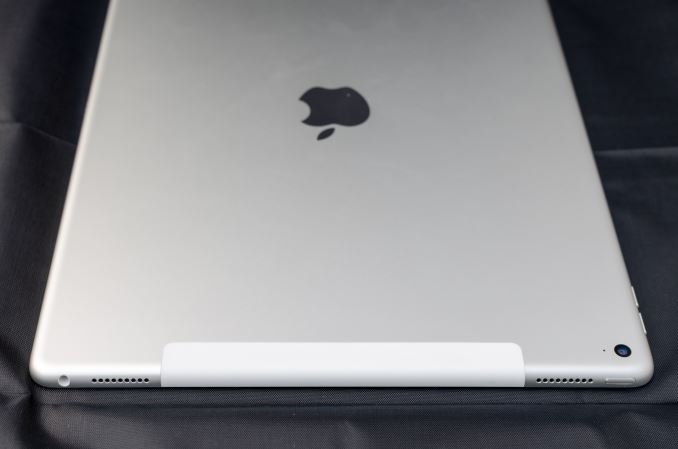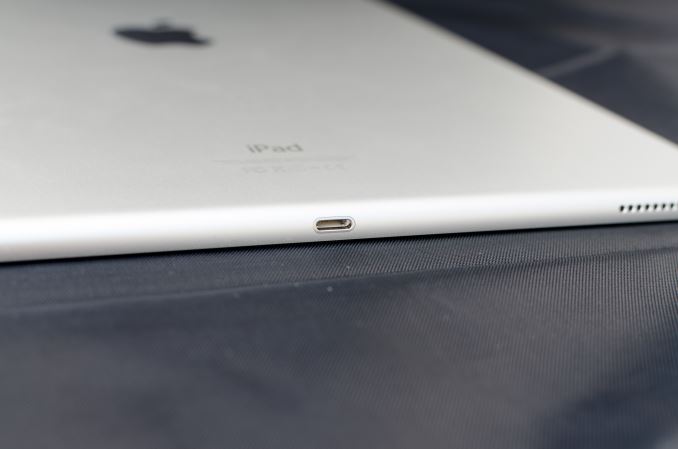The Apple iPad Pro Review
by Ryan Smith, Joshua Ho & Brandon Chester on January 22, 2016 8:10 AM EST
At this point it probably isn’t a secret that tablet sales have leveled off, and in some cases they have declined. Pretty much anywhere you care to look you’ll see evidence that the tablet market just isn’t as strong as it once was. It’s undeniable that touch-only tablets have utility, but it seems that the broader market has been rather lukewarm about tablets. I suspect at least part of the problem here is that the rise of the phablet has supplanted small tablets. Large tablets are nice to have, but almost feel like a luxury good when they’re about as portable as an ultrabook. While a compact laptop can’t easily be used while standing, or any number of other situations where a tablet is going to be better, a compact laptop can do pretty much anything a touch-only tablet can. A laptop is also going to be clearly superior for a significant number of cases, such as typing or precise pointing.
As a result, large touch-only tablets feel like they’ve been limited to home use as a computer away from the computer. Tablets are great when you’re on the couch or in bed, but once you get to this point there are some obvious questions as to whether it makes sense to drop $500+ USD on a tablet that seems to have relatively limited utility. The Surface lineup has been showing signs of growth, but in general the Surface is more of a mix between laptop and tablet rather than a tablet. I would argue that given the OS and overall design that the Surface and Surface Pro are really more laptop than tablet, even if at the hardware level the Surface Pro 4 and Surface 3 are basically tablets with kickstands and keyboard covers.
If you’re guessing that this means Apple has had some issues with growing sales of their iPad lineup, you’d be right. From my first experiences with the iPad 3, I was impressed with the improved user experience for things like web browsing and other smartphone tasks, but I never really felt like it made enough sense to get one for myself. The iPad Air 2 was once again impressive and I felt like I could recommend it to other people that wanted a tablet, but I personally struggled to come up with a reason why I would buy it.
This brings us to the iPad Pro. This is probably the first time Apple has seriously deviated from traditional iPad launches, putting together a tablet built for (limited) productivity and content creation rather than just simple content consumption, creating what's arguably the iPad answer to the Surface Pro. To accomplish this, Apple has increased the display size to something closer to that of a laptop, and we see the addition of a stylus and a keyboard cover for additional precision inputs. Of course, under the hood there have been a lot of changes as well, so the usual spec sheet can be found below to summarize those changes.
| Apple iPad Air 2 | Apple iPad Pro | |
| SoC | Apple A8X 3 x Apple Typhoon @ 1.5GHz |
Apple A9X 2 x Apple Twister @ 2.2GHz |
| GPU | PowerVR 8 Cluster Series6XT (Apple GXA6850) |
PowerVR 12 Cluster Series7XT |
| RAM | 2GB LPDDR3 | 4GB LPDDR4 |
| NAND | 16/64/128GB | 32/128GB |
| Display | 9.7" 2048x1536 IPS LCD | 12.9" 2732x2048 IPS LCD |
| Size and Mass | 240 x 169.5 x 6.1mm 437g WiFi, 444g LTE |
305.7 x 220.6 x 6.9 mm 713g WiFi, 723g LTE |
| Camera | 8MP Rear-Facing, f/2.4, 1.1 micron, 1.2MP Front-Facing, f/2.2 | |
| Battery | 27.3Wh | 38.5Wh |
| Launch OS | iOS 8 | iOS 9 |
| Cellular Connectivity | MDM9x25 Category 4 LTE + GPS/GNSS in Cellular SKU | |
| Other Connectivity | 2x2 802.11a/b/g/n/ac + BT 4.2, Apple Lightning | |
| SIM | Optional NanoSIM | |
| Price | $499/599/699 16/64/128GB | $799/949/1079 32/128GB/128GB LTE |
At a high level, the iPad Pro gains a larger display with a higher resolution, more memory, a new SoC, and a larger battery to compensate for the change in display size. In addition to these changes, the iPad Pro also brings noticeable changes to the speakers, with an increase to four speakers which allow the iPad Pro to compensate for device orientation when projecting stereo audio.
Design
The most immediate change that you can see in the iPad Pro is the sheer size. The 12.9” display of the iPad Pro basically makes it feel like you’re carrying a laptop around. I would argue that this doesn’t actually affect the portability of the iPad Pro, but this is mostly because the iPad Air 2 was something that I only carried in a backpack to begin with. People carrying their tablets in a small bag, purse, or even just in their hands will notice the difference, so the change in size might be more or less noticeable depending upon how you carry things around.
The increase in size does affect weight. After significant use, I honestly don’t think the mass is a significant issue. It does feel heavier than the iPad Air 2, but the mass distribution is such that there isn’t a ton of battery hanging out at the edges of the device where it’ll affect the moment of inertia. This does raise the question of whether Apple included enough battery for sufficient battery life, but that’s a question best left for the rest of the review.
In terms of design, the iPad Pro is rather unremarkable if you’ve ever seen an iPad Air before; it is for all intents and purposes a bigger iPad Air. On the front, the display dominates, with some bezels on the sides and top. The top has the front-facing camera, and the bottom has the home button with TouchID.
Looking at the sides of the tablet, the top edge has the power button and 3.5mm port, along with two of the four speakers. The right edge has the volume buttons, and the bottom edge has the Lightning port and the other two speakers. The left edge is mostly empty, but contains the Smart Connector for the Smart Keyboard and similar accessories.
The back of the tablet is mostly unremarkable as well. For the LTE model, an RF window is visible on the top of the device to allow LTE and other connectivity to function. For the WiFi variants, it looks like the bottom display bezel and the bottom two speakers are the RF windows, so there aren’t any visible areas that indicate where the WiFi antennas are.
Overall, the iPad Pro feels like an iPad, with nothing all that remarkable beyond its size which is carried well. I never really noticed the mass or size of the iPad Pro even if it is clearly larger and heavier than the iPad Air 2. I also didn’t notice any issues with the back cover flexing, but given enough pressure on the back cover pretty much any device this large will see some screen distortion or bending. The iPad Pro does technically regress in thickness compared to the iPad Air 2, but I never noticed the difference in practice, especially when the larger display is really what matters more.
















408 Comments
View All Comments
lilmoe - Friday, January 22, 2016 - link
ok......Sc0rp - Friday, January 22, 2016 - link
Well, I have to disagree with you on one thing here. I don't think Apple has any blame here when it comes to software. iOS9 is faaaaaaaar more powerful and capable than Mac OS 8 and 9 that I used to run on my power PC's back in the late 90's. Those computers were certainly productive. There's nothing on a software level that's really stopping developers from making productive software for the iPad Pro or even the Air. There is an interface challenge, much as there was an interface challenge when GUI's first came out. As I recall, people lambasted GUI's and mouses as being toys and not for serious work back then. The endless whining over the iPad Pro is just a reverberation of that. People don't like change and they don't like things that rub against their doctrine. But, consider this... While many adults actually have some difficulty adapting to this new computing paradigm, youngsters adapt to it like a fish to water.I think it is a wild boast to call an iPad Pro a 'useless toy'. I certainly have made a ton of use of mine. Of course, I'm an artist so there's that. Not to mention that my iPads have been my primary communication hub for the last five years.
Jumangi - Friday, January 22, 2016 - link
iOS blows as an actual productivity system. It is made for smartphones first(Apple's cash cow) and everything else second. Put a version of Mac OSX on this and you have something. Right now this is an expensive artists toy.strangis - Friday, January 22, 2016 - link
> While many adults actually have some difficulty adapting to this new computing paradigm, youngsters adapt to it like a fish to water.That's why I, as someone of the Commodore Vic 20 era, has to show relatives and clients 25 years younger than me how to use their phones, tablets and computers every week. Regardless of age, some people get it, some don't.
Similarly, I've never seen the value of an iPad Pro when, as an artist), I need to finish in Photoshop or After Effects. The creative tools available on the iPad Pro are limiting for those of us used to more, and considering its price, better to buy something that will get the job done.
Murloc - Saturday, January 23, 2016 - link
I have no doubt people will only use tablets once they'll be able to interact with the interface with their brains.Relic74 - Saturday, February 27, 2016 - link
Yea but at least Mac OS had a proper file-system, allowed it's users to select their own default apps, appsdidn't require API's in order to talk to the system, all applications used the same resolution, when a new feature was added to the system every app was able to utilize it immediately and didn't require it's developer to update their apps, the user was ablue to customize their desktop and even the UI, supported widgets, applications were windowed and ran desktop software. Actually, I take it back, Mac OS's UI was a lot more powerful, the system not so much, which is reversed in iOS, the UI isn't very powerful, it's actually pretty vanilla, though it's BSD underpinnings are extremely powerful. If I was able to access the BSD system, I would dump iOS's UI in a heart beat and install a X desktop environment like Gnome 3, which actually works fairly well as a tablet OS. Than maybe the iPad Pro would actually be a Pro device. I'm running Arch Linux on a Xiaomi MiPad 2, love it.NEDM64 - Friday, January 22, 2016 - link
Dude!If you were in the 80's, you'll be advocating text user interfaces instead of graphical user interfaces.
If you were in the 70's, you'll be advocating separate terminals connected to computers, as opposed to "all-in-ones" or "intelligent terminals" like the Apple II, Commodore PET, TRS-80.
Opinions like yours, with due respect, don't matter, because people like you, already have their rigs in place, and aren't in the market.
Apple's market position is for people that want the next thing, not the same ol' thing…
RafaelHerschel - Saturday, January 23, 2016 - link
Apparently the next thing is a larger iPad. I'm going to be bold and predict the next next thing. It's going to be a slightly thinner version of the larger iPad. Awesome.Murloc - Saturday, January 23, 2016 - link
you aren't understanding tilmoe's posts.You can spend millions developing software for a superpowerful tablet.
You will still never be able to fit Photoshop's whole interface and abundance of options and menus into the tablet in a way that the user is easily able to reach them, without scrolling through pages of big buttons.
At the end of the day, you'll get a crippled version of photoshop and the user will have to get on a traditional computer (a WORKstation, not because it's more powerful, not because software houses invest more in it, but because it has human interaction devices and a big screen that enable humans to get work done faster) to get stuff done.
Tablets are mostly content consumption products exactly because of the limited interfaces. They have the advantage of portability and ease of use, you just open apps while on the couch, and that's why they master content consumptions better than say laptops.
Constructor - Saturday, January 23, 2016 - link
It's by now become a quasi-religious belief system for some that "mobile devices cannot ever be used for any professional purposes whatsoever!".At the same time more and more people (and businesses!) don't care about such beliefs in the slightest and simple use those devices very much professionally and in many cases with more success and higher productivity than they'd had with conventional computers.
Part of the reason is that agility and flexibility often beats feature count, all the more so since professional workflows very often just can't afford to even consider most of the myriad theoretical options some desktop programs offer. Heck, most professional uses actually don't need much more than a browser interface anyway!
Yes, there are some uses for which desktop or mainframe computers will be the only really viable option. But what you and many others didn't seem to have noticed is that those domains have been shrinking rapidly over the last decade(s).